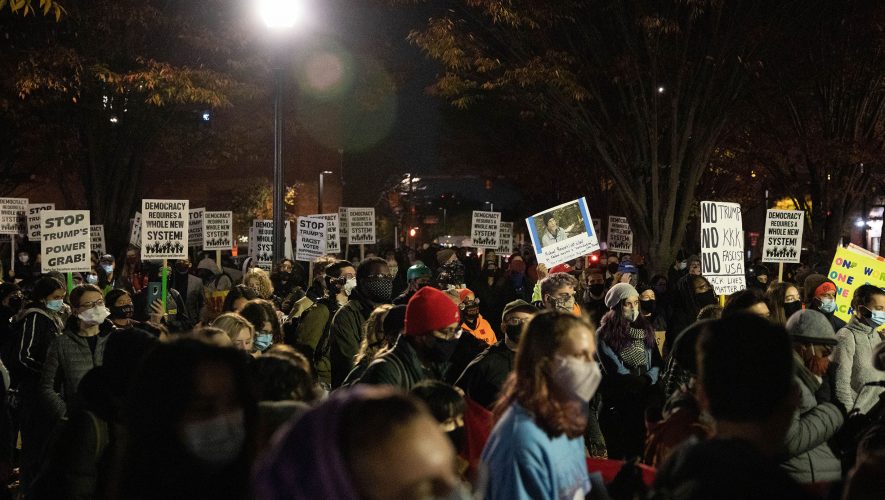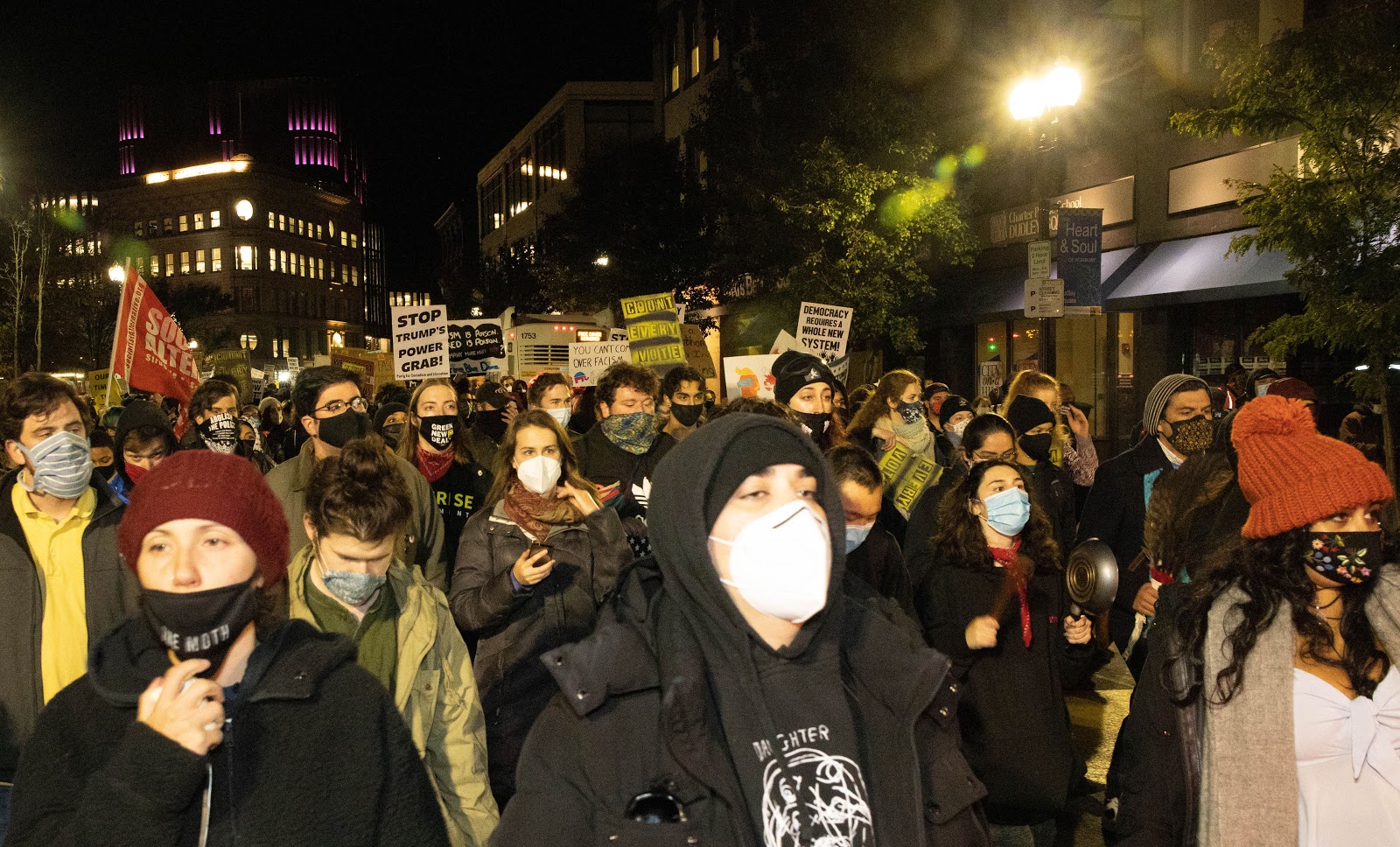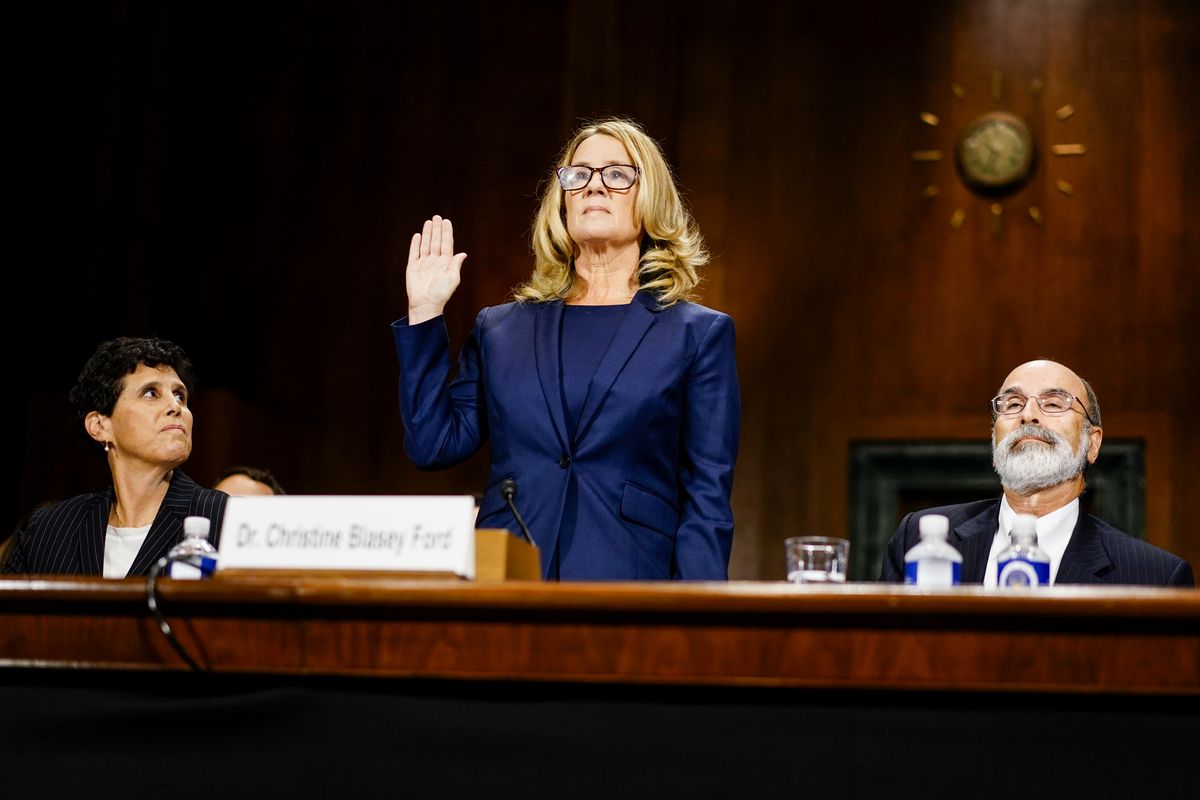Courtesy of Bill Wu
After an unprecedented delay in election results spurred anxiety throughout the nation, Joe Biden is poised to become the forty-sixth president of the United States come January.
Amid this uncertainty, President Donald Trump sowed distrust in the election process and increased tensions among voters, crying election fraud just as a child cries wolf. Swing states and Democratic strongholds have seen protests erupt in response to delayed results, with the right motivated by the false perception of foul play and counter-protesters compelled to defend the democratic process.
With cognitive dissonance influencing our country’s politics, Trump’s base sent conflicting messages to stop counting votes in some states and continue in others. They were encouraged by widespread conspiracy theories of fraud, which were promoted and boosted instantly by Republicans and right-wing social media users. Trump endorsed these theories in his election results speech from the White House and propagated this messaging on Twitter in unison with his aides. “Precarious” doesn’t begin to describe the situation.
As hours stretched into days and Biden’s path to victory became clear, Trump supporters and right-wing media outlets quickly declared this election rigged in favor of Democrats, opening the door for them to say the presidency was “stolen.”
On Wednesday, November 4, Trump announced prematurely and incorrectly that he had won, even though votes were still being counted in key states. Protests erupted in cities across the US, with citizens expressing outrage for widely different reasons.
Two clear conflicting Republican narratives materialized in pro-Trump protests––his supporters called to “Stop the count” in Pennsylvania where Trump had a narrow lead, while the very same base demanded that Arizona “Count every vote,” as the Associated Press had called the race for Biden.
After Fox News called Arizona for Biden, protesters—many of them armed—stood outside of the Maricopa County recorder’s office where votes were being counted. Energized by baseless rumors that ballots were being discarded to “steal” the election, Trump supporters chanted “Fox News sucks” and “stop the steal.” In reality, county officials had been working tirelessly through the night to count all votes. While the county had long been a Republican stronghold, this year it turned blue, as did the state as a whole.
The conflicting messages from Trump supporters are customized to serve the same ultimate goal: maximize Trump’s now non-existent chances for re-election by protesting non-existent voter fraud.
Trump energized these supporters through flimsy lawsuits that targeted battleground states. He filed multiple suits to compel election officials in Pennsylvania to stop counting the remaining ballots, as that would have granted him victory there at the time of filing. In Georgia, he sought to disqualify about fifty-three ballots from a blue county, falsely claiming they arrived after the 7 p.m. Election Day deadline. As Trump’s lead narrowed in these states, he repeated his baseless claims of fraud. In Arizona and Michigan—which flipped blue—Trump argued that absentee votes were not counted properly, laying the groundwork to contest the outcome.
There is no evidence that Biden “stole” this election and no signal of widespread voter fraud. In Pennsylvania, the state Trump filed the most lawsuits in, legal observers did not report any fraud or ballot concerns. Nonetheless, Trump didn’t hold back in tweeting as the growing tally of ballots narrowed his lead over Biden in some states.
STOP THE COUNT!
— Donald J. Trump (@realDonaldTrump) November 5, 2020
Twitter added warnings to many of Trump’s tweets, indicating that they presented inaccurate information.
Trump’s actions ultimately incited chaos and provoked distrust within an already agitated electorate. Pennsylvania’s governor condemned calls to stop the count. Still Trump supporters demonstrated outside of the Philadelphia Convention Center on Thursday, while counter-protesters called for the preservation of democratic elections through demands to count every vote.
Ironically, stopping the count would have ensured Trump’s loss. Senior advisors reportedly had to explain to the president that he needed to be more precise about which votes to disregard. He later tweeted “STOP THE FRAUD!” which Twitter rightly flagged as misleading.
Many internet users found humor in these baseless attacks, responding to false rhetoric in right-wing spaces with memes. And while the race has been called for Biden, Trump supporters insist the election is not over as they protest his loss based on the fallacy of foul play.
There’s no stopping the count! pic.twitter.com/NO7jOksgdD
— Collette (@collette24) November 5, 2020
Ah ah aha one, one fascism pic.twitter.com/WFTZuXQxg7
— James Felton (@JimMFelton) November 5, 2020
These contradictory, politically polarized calls to action reflect the hyper-partisan landscape that defines identity politics and the hotly contested presidential election.
The goal for leftists and liberals seems to be the preservation of what’s left of American democracy. In Boston, anti-fascist advocacy groups scheduled demonstrations for November 4, and a new base of protesters emerged in response to Trump’s provocation. Bostonians young and old paraded signs that read “Stop Trump’s voter fraud” and “Protect democracy.” The anger was electric and the message was clear: oust Trump and Pence.
Courtesy of Bill Wu
New York saw a similar eruption of pro-democracy, anti-Trump actions as protesters demanded for every vote to be counted and for racial equality. But battleground states—specifically those that saw delays in their election results—are key to understanding this cognitive dissonance. The margin in Georgia was so close, virtually a tie, that the state announced a recount, stretching the process further still and re-energizing the flood of baseless voter fraud claims spewing in from the right.
Trump’s goal, which some of his base adopted, was to stop counts in states where he led and continue counts in states where he trailed. He wanted to secure red-leaning states and flip blue ones through voter suppression. He coupled this tactic with declarations of foul play in states where he was not declared the winner.
Trump’s actions were expected, given that the president did not commit to honoring the election results or to initiating a peaceful transfer of power. Protests were equally likely given the anger many citizens hold toward his administration and the two-party system. And sustained tensions amplified by this summer’s Black Lives Matter protests informed calls for transparency, as demands for police accountability and justice against brutality peppered calls to count all votes.
Pro-Trump groups pledged on Thursday to keep protesting outside of ballot-counting locations in Phoenix, Philadelphia, Las Vegas, Atlanta, and Detroit. Many demonstrations are fueled by conspiracy theories that Democrats forged ballots for Biden by using the names of dead citizens and that people destroyed ballots containing Trump votes.
Unsurprisingly, these claims spread across right-wing social media accounts and echoed in Trump’s election results speech, which was so dishonest that many outlets fact-checked it in real time; others stopped televising it altogether. The insidious edge to the powers of social media and viral content in spreading information is that these tools are just as effective at spreading disinformation.
The steady rise of alt-right conspiracies was long poised to play a central role in the 2020 election and its aftermath. Trump and those closest to him perpetuated distrust by boosting conspiracy theories about ballot burning, dangerously promoting ideas tied to the infamous right-wing conspiracy QAnon. The network of QAnon supporters believe a government insider is leaking secrets about the American establishment, asserting that institutions are run by a network of Satan-worshiping pedophiles who are conspiring against Trump.
Some journalists used social media to debunk election conspiracy theories in real time, revealing the completely unfounded nature of claims while highlighting just how fast disinformation can spread and mobilize citizens on the ground.
@gadischwartzNews people are NOT sneaking in extra ballots🤦🏻♂️ #News #Election2020 #Maricopa♬ original sound – Gadi
The protests following this election are some of the clearest examples of the cognitive dissonance that defines the ideology of many Trump supporters. It also explains why they rationalize their support for the racist, sexist former reality TV star.
The state of disinformation is revealed when contradictory demands are recited without shame or any attempt to conceal the cognitive dissonance at their core. As Trump works to undermine American democracy yet again, his lies have finally come back to bite him.




